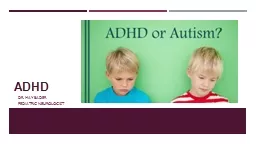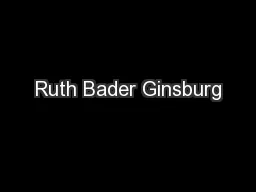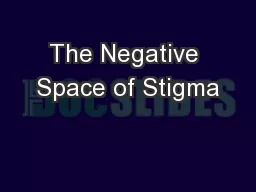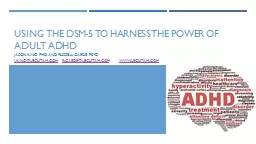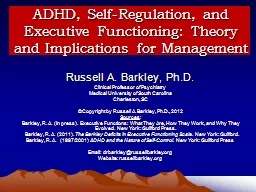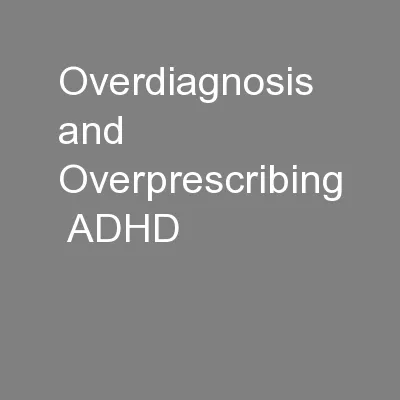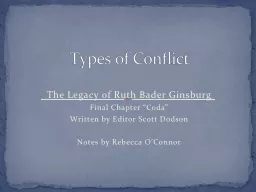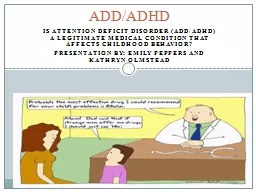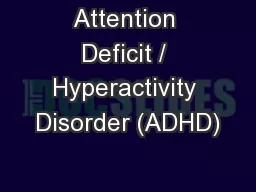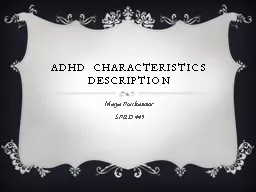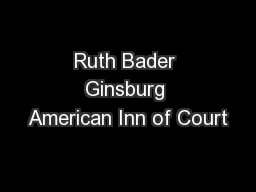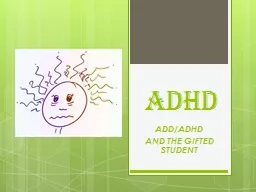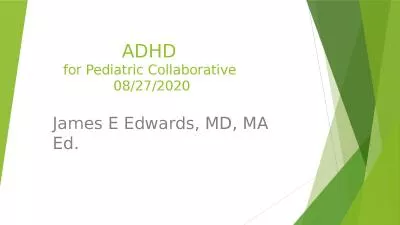PPT-ADHD DR. May bader Pediatric neurologist
Author : LuckyLadybug | Published Date : 2022-08-03
INTRODUCTION Definition ADHD is a disorder that manifests in early childhood with symptoms of hyperactivity impulsivity andor inattention The symptoms affect
Presentation Embed Code
Download Presentation
Download Presentation The PPT/PDF document "ADHD DR. May bader Pediatric neurolo..." is the property of its rightful owner. Permission is granted to download and print the materials on this website for personal, non-commercial use only, and to display it on your personal computer provided you do not modify the materials and that you retain all copyright notices contained in the materials. By downloading content from our website, you accept the terms of this agreement.
ADHD DR. May bader Pediatric neurologist: Transcript
INTRODUCTION Definition ADHD is a disorder that manifests in early childhood with symptoms of hyperactivity impulsivity andor inattention The symptoms affect cognitive academic behavioral emotional and social functioning . V-JSAT2-May-15SUN3-May-15MON4-May-15V-BTUE5-May-15V-L/BV-JWED6-May-15THU7-May-15FRI8-May-15V-L/BV-JSAT9-May-15SUN10-May-15MON11-May-15V-BTUE12-May-15V-L/BV-J13-May-15THU14-May-15FRI15-May-15V-L/BV-JSA American Inn of Court. 26 Attendees. 13 Inns of Court. Topics. History. Budget & Finance. Planning & Administration. Idea Sharing. Retention and Attendance. Mentoring. Achieving Excellence. Leadership Summit. Race, Place and Health Inequality. Michael Bader. Conn. Multicultural Health Partnership, June 20, 2013. Slides presented at annual meeting of the CT Multicultural Health . Partnership. . The Negative Space of Stigma by Michael Bader is licensed under a . Jason King, PhD and Russell Gaede, . PsyD. j.king@lecutah.com. . r.Gaede@lecutah.com. . www.lecutah.com. . Now a neurodevelopmental disorder. Pollak, J., Levy, S., & . Breitholtz. , T. (1999). Screening for medical and neurodevelopmental disorders for the professional counselor. . Executive Functioning: Theory and Implications for Management. Russell A. Barkley, Ph.D.. Clinical Professor of Psychiatry. Medical University of South Carolina. Charleston, SC. ©. Copyright by Russell A. Barkley, Ph.D., 2012. Diagnosed and treated with medication . Diagnosed, but should . seek other . alternatives. ADHD . does not actually exist. Photo credit: Corbis. One of the most common childhood disorders and can continue through adolescence and adulthood. Symptoms include difficulty staying focused and paying attention, difficulty controlling behavior, and hyperactivity.. Final . C. hapter “Coda”. Written by . E. ditor Scott Dodson. Notes by Rebecca O’Connor. Types of Conflict. Ultimately, she seems to believe that judges can and should strive to make the legal system a positive agent for good. And even when she is on the dissenting side of an opinion, she does not give up but rather uses oral argument to . ?. Presentation by: Emily Peppers and Kathryn Olmstead . . ADD/ADHD. What is ADD/ADHD?. ADD = Attention Deficit Disorder. ADHD = Attention Deficit Hyperactivity Disorder. This disorder makes it difficult for people to function properly within the world. It is difficult for people to inhibit spontaneous responses (speech, movement, attentiveness, etc.).. Common Symptoms, Differential Diagnoses, and Treatment Options. Dr. . Rachel Andaloro. Metrowest. . Neuropsychology . ASHPAC . meeting 3/17. ADHD . One of the most common childhood . disorders. Marya. . Puttkammer. SPED 445. Identifying ADHD. ADHD – Attention Deficit Hyperactivity Disorder. Teachers should monitor their students at all times. Students with ADHD in high school may “develop low-self esteem, frustration, academic underachievement, even failure, and social isolation” if it goes unrecognized and untreated. ADHD can be recognized in students if they are not focusing, turns in messy work that was probably rushed or incomplete work or work with many errors, blurts out answers before question is completed, assignments may be misplaced most of the time (resource 1).. MD. , . Associate . Professor of Emergency . Medicine Stanford . University School of Medicine. David Tong, MD. , . Director, Telemedicine Network, California Pacific Medical Center. George Oldham, MD. 26 Attendees. 13 Inns of Court. Topics. History. Budget & Finance. Planning & Administration. Idea Sharing. Retention and Attendance. Mentoring. Achieving Excellence. Leadership Summit. “What [i]s imperatively needed [i]s more emphasis on professional ethics, on manners and deportment in the courtroom and in the practice; in short, the necessity for civility in what is inherently a contentious human enterprise.”. Attention deficit (hyperactivity) Disorder. These twice exceptional students may have LAYERS of abilities and disabilities that can hide behind each other, deceiving the most discerning observer. . 1. 08/27/2020. . James E Edwards, MD, MA Ed.. Disclosures. This discussion will contain reference to some pharmaceuticals that have not been approved by the FDA. for children, adolescents and/or adults for some of the uses outlined in the lecture (“off-label”)..
Download Document
Here is the link to download the presentation.
"ADHD DR. May bader Pediatric neurologist"The content belongs to its owner. You may download and print it for personal use, without modification, and keep all copyright notices. By downloading, you agree to these terms.
Related Documents

